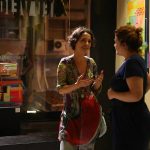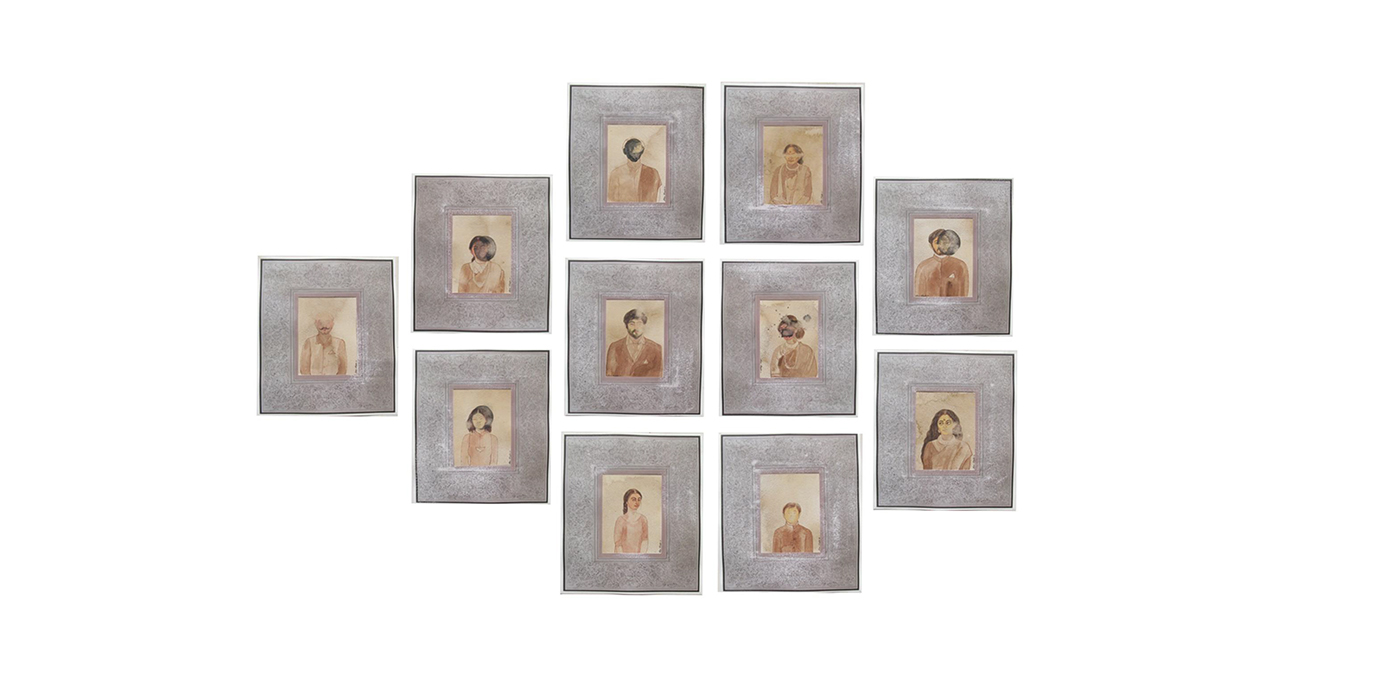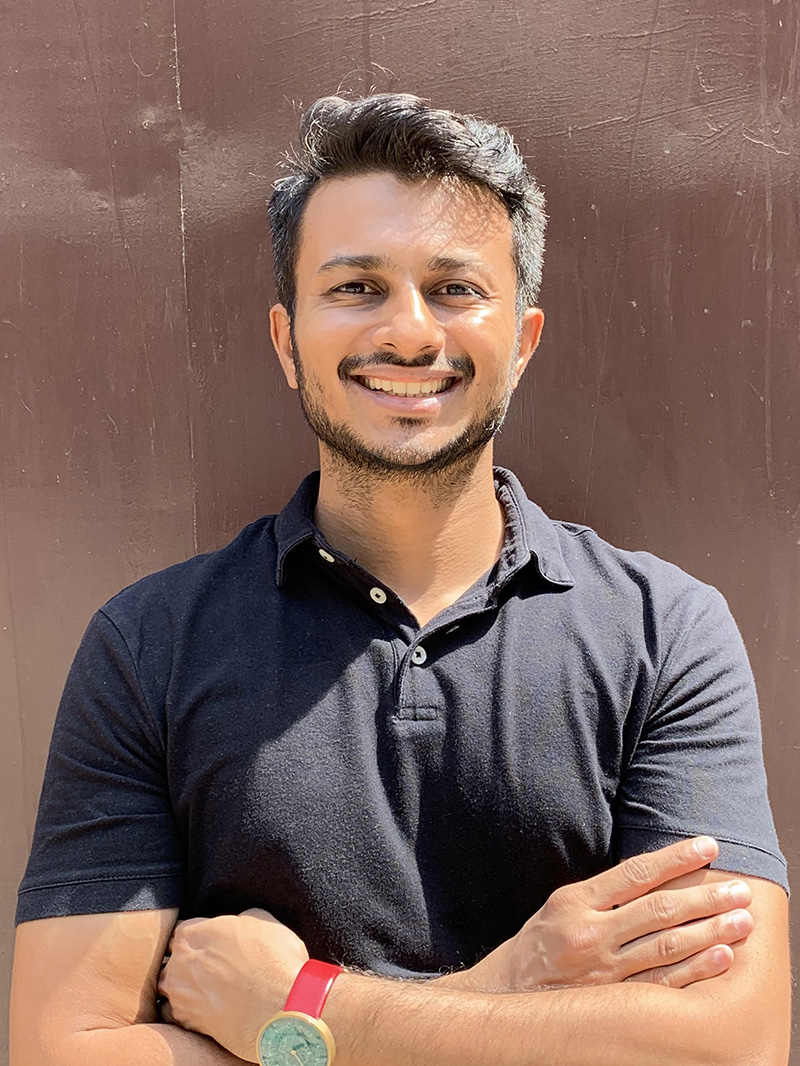Indian contemporary artist Ekta Singha strives to create multidimensional surfaces suffused with personal myths, experiences, anecdotes and observations.
My art is a juxtaposition of memories, metaphors and histories. I strive to create images that engage viewers, not only visually but also cerebrally.
Indian contemporary artist Ekta Singha
Featured image: I wish they could have come too. 8 x 10 in. Mix media. 2019.

Indian contemporary artist Ekta Singha
Please tell us a little about yourself, what brought you to the world of art and how did you start?
I was born and brought up in Kolkata, West Bengal, India. My dad was an art teacher and mom, homemaker. My interest in art was first recognised by my mom (Krishna Singha) when she found me copying my dad’s designs for children garments, at the age of three. So she took me to a children’s carnival to participate in a sit and draw competition where I was placed third, and that made my dad notice my interest in art, and he started teaching and encouraging me. My family and school have always played a supportive role throughout my journey.
My interest for fine arts gradually developed into my passion. After my Boards, I was selected in all the major institutes and I took admission in Government College of Art and Craft, Kolkata, where I completed my BFA in Painting in 2012 and did my MFA in Painting (Mural) from Faculty of Fine Art, MSU, Baroda, Gujarat, India in 2015. And since then I am based in Baroda practicing independently.

I want a perfect family photograph. Indian contemporary artist Ekta Singha. 3 x 3 feet. Pigment colour, gouache, graphite on linen. 2018.
What is the primary role of an artist? How do you describe yourself in the context of challenging people’s perspectives via your work and art?
Every artist plays his or her own unique and important role in contributing to the overall development and well-being of society. Artists provide their communities with inspiration, interaction and joy, while they also thoughtfully critique our socio-political, and economic systems. My art is a juxtaposition of memories, metaphors and histories. I strive to create images that engage viewers, not only visually but also cerebrally.
How do you deal with the conceptual difficulty and uncertainty of creating work?
Anecdotes and memories of my ancestral home and lineage in Bangladesh had played a strong role in my work. Creating patterns remain an integral part of my work and not just as an ornamental design. Rather it becomes an important visual tool to subtly transform experiences – disturbing events and memories through its consistent appearance. This is an attempt to create a visual trope with the imageries, so that they don’t become too didactic, but at the same time demand certain attention from the viewers in order to articulate the works. I look towards motifs, anecdotes, memories and my experiences as a resource when I deal with conceptual difficulties. I also draw, sketch and read avidly, which helps me clear the uncertain blockages I come across while working.

I wish they could have come too. Indian contemporary artist Ekta Singha. 8 x 10 in. Mix media. 2019.
What would you call your style? Let’s talk about the evolution of your practice over the years. Tell us about your commitment to your current medium.
It is very difficult to give a particular name to my style of work but yes it has multilayers in it and the crux of my work is the personal interpretation of layers of experiences woven with paraphernalia of design motifs, forms and elements derived from miniature paintings. Medium and material are both important parts of my work, as manipulation of mediums and forms helps me create a layered image that is imbued with fragments of photographs, texts and found images/objects and designs. Finally, the resulting image, is an expansive terrain of multiple visual elements that constructs and manipulates each other’s existence and eventually creates a new image altogether.
I often use burnt papers and hand crafted papers to create the form of Jalis with geometrical designs (from Islamic architecture) and antique textures all add up to create the metaphorical surface of my work. I use them to control the gaze of the viewer, like a hide and seek – where I can either hide certain images or invite the viewer to cherish the painting and seek images beneath the layers. The old reference photographs are not only used to document history and family chronology, but also to create a visual sensation. The figurations in my work itself talks about body politics and personal diaries. There is an interesting amalgamation of two traditions in my work; one is the tradition of miniature painting and the other Pata scroll paintings. The miniature visual elements help me to create the desired pictorial surface but the scroll format helps me to craft an expansive terrain that alike the Pata paintings creates a sense of movement in the pictorial surface.

Still find some place anyway. Indian contemporary artist Ekta Singha. 14 x 9 in each. Gouache, pigment, graphite, print and found objects on Wasli Paper. 2019.
What inspires you? Let’s talk about your frameworks, references and process.
My interest in Mughal, Persian, Rajput miniature paintings as well as Pata paintings has helped me generate a language of my own. Then it’s the visual experiences in different point of time that I have received consciously and subconsciously that makes its entrance in pictorial surface that is layered with metaphorical and personal references.
Let’s talk about your career, or if you prefer artistic journey. What were your biggest learning and hiccups along the way?
As I started this journey at a very young age, I have faced some obvious hindrances and big learnings too. It is great to explore an uncertain journey, however, the overall experience has been amazing, I never lost hope, and whenever I face difficulties, I try to look back and figure out my faults to correct them in future. I never stopped learning or exploring new elements, which is why you can find an array of materials and mediums in my work, creating multidimensional surfaces suffused with personal myths, experiences, anecdotes and observations.

Still find some place anyway IX. Indian contemporary artist Ekta Singha. 14 x 9 in each. Gouache, pigment, graphite, print and found objects on Wasli Paper. 2019.
What are you looking for when you look at other artists’ work? Which shows, performances and experiences have shaped your own creative process? Who are your maestros?
Understanding art is a research in itself, where one needs to have a perception to acknowledge the thought processes. For me personally, I like to look at works with a free mind so it helps me understand the world of an artist. An artwork or a performance should leave at least a faint mark in the viewer’s mind, so that it can provoke thoughts and create new possible meanings to the time and space. For me, looking at works of other artists is an important part of my practice, may that be my peers or maestros, it always gives me some food for thought when I come across works which provoke me to think. Sometimes their presence becomes so strong that I try to connect with the thoughts in my dreams also.

Joint family II. Indian contemporary artist Ekta Singha. 22 x 31 in. Gouache, graphite, acrylic, Nepali handmade on Wasli paper. 2018
How does your interaction with a curator, gallery or client evolve from the initial interface, to the working-involvement-relationship?
When one is practicing as an individual it totally depends on communication and connections. Without interacting with curators and galleries it is very difficult to channelise your work and reach the audience. The art world is totally based on networking and nowadays social media also plays a big role in networking. We artists usually build our connections by applying for open calls and residencies. I prefer critical conversations with curators and galleries so they have an understanding of my work and I feel comfortable when the other person has an in-depth knowledge about art and culture in general then it becomes a fruitful interaction where I welcome critical feedback from them.
Think of the biggest professional risk you have taken. What helped you take that risk?
After completing my masters, I stayed in Baroda to continue my independent practice, but to earn a living I took up a part time teaching job as an art teacher in a school, and practiced art quietly. After almost a year and a half, I connected with a gallery in Delhi. They liked my work and offered me a show. After the show, they decided to showcase my work at the India Art Fair 2018.
This was a very crucial time for me, preparing myself for India Art Fair was a totally new experience, and I had to put in my hundred percent so I decided to quit the job and start practicing full time in the studio. That time I did not have much savings and I did not even know how to pay my next rent for the studio, but somehow I managed with the support of family and friends and survived. Now I think that, if I had not taken the risk at that time, I could not have explored the field so much in such a small span of time.

Still find some place anyway IV. Indian contemporary artist Ekta Singha. 14 x 9 in each. Gouache, pigment, graphite, print and found objects on Wasli Paper. 2019.
Any mentor, curator or gallerist who deserves a special mention for furthering your journey? What is the best piece of advice you’ve received?
Exploring this field wouldn’t have been possible without my parents’ support. My first mentor was my dad Mr Biswanath Singha. He started teaching me art when I was just 3 and half years old.
In my BVA 1st year, I met artist and art educator Tarun Dey, a person who changed my conception about art completely. He made me understand what is art and encouraged me to trigger my thoughts to question what I am doing and why I am practicing art. Tarun Dey and Bhabotosh Suthar introduced me to the group they founded along with other members called Environmental Art in Behala, Kolkata. This was a big shift in my life to understand art. Since then for the next four years, I used to visit them regularly, taking an active part in various discussions, workshops, outings, talks and other activities. Tarun Dey also made me understand how important it is to be independent in life. And then when I shifted to Baroda for my masters, I was mentored by Vasudev Akkittam, Indrapramit Roy, Jayanti Rabadia who not only nurtured my creative perspectives but also stood by me in every situation.
The best advice, was from my dad who always told me, “do follow your passion, make it your madness and this madness will lead you towards your goal”. And my mom, who is an art lover with great knowledge about art, told me to be a good human being first, only then can you become a good artist because art always reflects your soul.

Indian contemporary artist Ekta Singha, in studio.
Tell us about your studio, what kind of place is it? Could you describe your usual work-day in the studio?
Studio is the place where I meditate. Therefore, for me everything is attached to it, that is why I prefer to have my living space and studio together so that I have 24 x 7 access. I have recently shifted to a new studio that is quite spacious and I have a cozy balcony where I planted many plants because for me greenery is very essential and flora has always played an important part in my work.
I don’t have any fixed studio timing, but I try to spent at least 4-5 hours in studio every day. I utilise the time writing, planning new projects, layouts and preparing materials, contemplating and completing ongoing works. I love reading, gardening and listening to music. Baroda also has a good culture of visiting artist studios and interacting with each other. So, whenever I feel like, I just go out for a visit and talk to them and the discussions give a new perspective to my thought process.
Are you more of a studio artist or naturally collaborative by nature? How do you feel about commissions?
Yes, I am more of a studio artist. I spend a major part of the day in studio. Of course, nature integrates into my multidisciplinary practice, but majority of my work is produced in the studio.
I take up commissions sometimes, if the work is relevant to my practice. Recently I did a project with eminent designer and scenographer Rajeev Sethi for a corporate headquarter in Ahmedabad. It was a huge project and interestingly the theme of the project was diversity which is very relevant to my way of seeing art. While working on commissions, I prefer to flourish in my own compound of practice.

Joint family II. Indian contemporary artist Ekta Singha. 22 x 31 in. Gouache, graphite, acrylic, Nepali handmade paper on Wasli paper. 2018
What was your first sale? Do you handle the commercials yourself or is it outsourced?
I was in 9th standard when I first sold my painting, from a show in Kolkata curated by a group of senior artists called Achin Patua. As most members of the group knew me through my dad, they invited me to show my work. For the first time, I had an opportunity to exhibit my work and my work was collected by one of the art collectors of Kolkata.
Now, I usually handle my commercials as an independent artist and if the deal is connected through a gallery, then the gallery takes care of it on my behalf.
How does your audience interact and react to the work you put out into the world?
I give full liberty to my audience to translate my work using their own intellect. I prefer not to impose my thoughts on them. I have a narrative way of executing my idea and concept on canvas so there is a chance of directing the audience to react accordingly but, I always try to break that monotony and push my audience to interact in their own way.

Excavating roots II. Indian contemporary artist Ekta Singha. 3 x 5 feet. Graphite, gouache, acrylic pigment colours and Nepali handmade paper on linen. 2018.
What are you working on now? What’s coming next season?
I continue to work on my ongoing series, and along with that, I am planning and researching layouts for my next series. I had plans to visit Bangladesh for research and documentations but for now it has been postponed indefinitely.
What were you working on when the lockdown was announced?
Just a moth before the lockdown was announced I completed my latest project and after that, I was travelling. I just returned and the lockdown was announced. So I was not exactly working but was planning for upcoming works and was reading.

Existential delineate – II. Indian contemporary artist Ekta Singha. 8 x 8 x 8 in (3D). Drypoint on Acrylic sheet, fresco on found bricks and wood. 2019.
How has this affected your practice and plans?
I usually work from studio and my studio is attached to my house so it did not affect my practice much physically, but yes, slowly its effects entered my thought process. Consciously or perhaps subconsciously, the motionless atmosphere around us has amalgamated in my paintings.
What would elevate artists’ life during this period?
In this time of crisis and uncertainty, as the world stagnates, social media is playing a very important role in the field of art. There are constant webinars, talk shows with artist and curators, online exhibitions, everyday art challenges etc. along with this there are few groups of artists and organisations who came forward to support artist like Carpe Arte, Art Chain India, and Young art support, who came up with the idea of selling art works online and without any commissions. It became a great change for artists in this lockdown period.
Somehow few good things came into existence. Everyday there is some new thing happening in social media. In this pandemic situation .

Existential delineate – III. Indian contemporary artist Ekta Singha. 8 x 8 x 8 in (3D). Drypoint on Acrylic sheet, fresco on found bricks and wood. 2019.
How are you balancing life and work at home during this period?
I am spending more time in my studio, reading books and planning future projects for last few months as there is no other works to rush for. Spending some good time in video calls with my family and friends and taking care of myself to stay safe and healthy.
Before you go – you might like to browse our Artist Interviews. Interviews of artists and outliers on how to be an artist. Contemporary artists on the source of their creative inspiration.












Add Comment